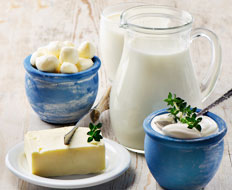In its most recent Statistical Abstract of the U.S., the U.S. Census Bureau revealed that per-capita consumption of dairy products grew about 7 percent between 1990 and 2009, from roughly 568 to 607 pounds per person per year. That’s a slow and steady rise, though not the sort of eye-popping increase that typically sends menu developers scurrying to the ideation kitchen with dollar signs in their eyes. But dig a little deeper into the bureau’s findings, and some interesting trends reveal themselves.
For instance, Americans are eating a heck of a lot more yogurt today than they were during the George H.W. Bush administration—about 200 percent more, to be precise. In 1990, consumption stood at about 8 pounds per person. By 2009, the figure was 23 pounds per person, and that was before most American consumers had discovered the rich, tangy wonders of Greek-style yogurt, which, according to the market-research group Packaged Facts, now constitutes about 35 percent of yogurt’s U.S. market share (compared with almost 0 percent as recently as 2007).
We’re eating 33 percent more cheese, too—roughly 32.8 pounds per year, compared with 24.6 in 1990. Within that category, Italian cheeses such as Mozzarella have fared particularly well, with Americans eating roughly 55 percent more of the stuff than they did two decades ago.
Quick serves haven’t ignored these growth trends by any means. On the contrary, they’ve served up everything from yogurt parfaits to frozen-yogurt cones; slathered more and better cheeses on their burgers, sandwiches, and salads; and found some enterprising uses for ice cream (maple bacon milkshake, anyone? I’m looking at you, Denny’s). The fact is, though, that there’s a world of dairy possibilities emerging in nearly every daypart and menu category. Perhaps the best way to conceptualize those opportunities is to evaluate the potential creative applications within two broad dairy subcategories: fresh and fermented.
Fresh Idea No. 1: Better Butters. Butter is a relatively rare commodity in many quick-serve establishments in 2013, primarily because of its price: Frying in oil is almost invariably less expensive than using dairy fat. But I’m thinking less about butter’s utility as a frying medium and more about its appeal as a flavor enhancer. High-end restaurateurs have for years prepared their own butters, incorporating everything from herbs, wine, spices, olive oil, and even yogurt into their spreads. And because butter’s flavor is by nature quite intense, it is an incredibly efficient vehicle for delivering a big burst of flavor.
Fresh Idea No. 2: Beverages, Enhanced. Despite the uptick in latté and cappuccino consumption, Americans are drinking less milk overall than they once did. But just wait until they start developing a taste for concoctions like licuados—Mexican-style smoothies made with a milk base—beer milkshakes of the Samuel Adams variety offered by Red Robin, or chocolate milk–based sports drinks and other novelty products. Milk, it seems, is ripe for reinvention and exploration, as Cow Wow Cereal Milk ably demonstrated at the March 2013 Natural Products Expo West in Anaheim, California. The company’s niche? Individual-sized servings of organic milk imbued with the flavor of kids’ favorite breakfast cereals. If you’ve ever pined for a slug of the thick, sweet dregs left at the bottom of your bowl after plowing through a serving of Froot Loops or Cocoa Puffs, your prayers have been answered.
Fresh Idea No. 3: Desserts That Deliver. Frozen fruit pops have a distinguished history and a big fan base in the U.S., but there’s only so much you can do with a water or fruit-juice base. When you broaden the ingredient options to include milk, cheese, or yogurt, however, the options become a whole lot more interesting and the textures more satisfying. Our trend-spotters at CCD Innovation have recently spied blueberry goat-cheesecake pops, strawberries and cream with basil paletas, and a lemon curd/gingersnap pop with a dairy base. Meanwhile, Kulfi pops from India are denser than the ice cream or yogurt pops better known to Westerners, but they’re at least as delicious, with popular flavors such as cardamom, pistachio, rose water, and saffron.
Fermented Idea No. 1: Yogurt. Yogurt’s surge is evidence not just of its many health benefits, but also of its flavor and texture, which makes it versatile enough to substitute for butters and oils in some low-fat recipes, and tasty enough to impart a creamy mouthfeel to desserts, salad dressings, soups, and condiments. Greek yogurt’s higher protein content and slight astringency make it even better for many recipes; expect to see it continue to turn up in interesting ways in the frozen-dessert aisle and in cookbooks.
Fermented Idea No. 2: Cheese. While fresh cheeses such as goat, Ricotta, Burrata, and Mascarpone—cheeses that are mild, soft in texture, and bright and flavorful in character—are extremely pleasing to the palate, fermented cheeses are the ones that typically pack a flavor wallop. Aging with yeasts and molds yields pungency; bite; a thicker, chewier texture; and some truly distinctive flavors. European styles such as Edam, Muenster, and Gouda; Oaxacan cheese from Mexico; and even good-old American Colby from Wisconsin can work beautifully on sandwiches, in salads, and just about anywhere else Cheddar, Swiss, and Jack cheeses are typically employed today.
My message, then, is that dairy has for years been underexploited in a quick-serve context. If you’re looking for ways to inject a little more flavor, creaminess, and richness into your offerings, it’s high time to milk it.









